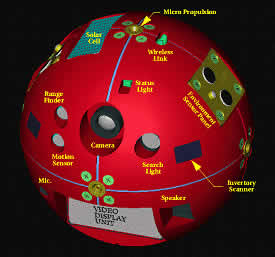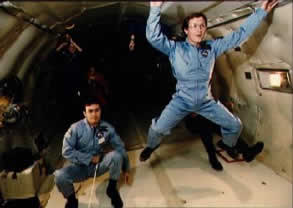|
Inspired by science fiction classics, NASA
scientists are building a talking, thinking and flying droid robot
to help astronauts with their chores in space.
By Patrick L.Barry
It looks like something straight out
of a Star Wars movie. And to hear it described - a self-propelled,
floating, talking, computerised personal assistant with artificial
intelligence - you might suspect it really is a "droid" from a science
fiction film.
The similarity isn't a coincidence.
The design was actually inspired by the small floating sphere that
Luke Skywalker sparred against in the original Star Wars!
The idea may have its roots in science
fiction, but this droid is quickly becoming a reality at NASA's
Ames Research Centre.
Soon these little robots, called "Personal
Satellite Assistants" (or PSAs for short), may be flying on board
the space shuttle and living in the International Space Station
(ISS). They will help the crew save valuable time by assisting with
routine chores. And they could be lifesavers when emergencies arise.
"I looked a little bit at the light
sabre training remote in Star Wars. That was part of the
inspiration for [the PSA]," says Yuri Gawdiak, who originated the
PSA concept and is now the project's principal investigator.
Another science fiction classic - Star
Trek - gave some of the astronauts an idea for a tool that would
be useful on missions.
"The astronauts requested a 'tricorder'-like
capability," Gawdiak says, referring to the portable device that landing
parties on Star Trek would use to survey the atmospheres of
alien planets.

Pictured is Yuri Gawdiak, principal investigator for the project
at the NASA Ames Research Centre. It may
look like something out of science fiction, but this softball-sized
robot helper could soon be aiding real-life astronauts with
their daily tasks.
|
"We took it a step further and said
we can give you a 'tricorder' and a personal digital assistant
... and make it autonomous," Gawdiak says.
Like the fictional tricorder, the PSA
will have sensors that can detect the pressure and temperature of
the ambient air, as well as concentrations of gases such as CO2.
For astronauts living in a sealed aluminium can in the vacuum of
space, this kind of information can be a matter of life and death.
"It's kind of like having a canary
on your shoulder," says former PSA systems designer John Loch. Miners
used to keep a caged canary down in mine shafts to act as an early-warning
device for subterranean methane that sometimes asphyxiated miners.
"If the canary starts getting dizzy,
you'd better start heading for your spacesuits," Loch says.
PSAs can also venture into situations
that might be too dangerous or uncertain for their human cremates."
Astronauts might seal off one of the modules if there's a suspected
problem, and then have the PSA check it out before humans go in,"
Loch says.
But crew members won't need to wait
for an emergency to make use of their PSAs. The little softball-sized
robots can help out with many day-to-day tasks as well.
"For example, if a crew member is taking
something apart, the PSA could be floating over their shoulder and
helping by telling them, 'Okay, remove this cover, take this latch
off, move this wire over here, and so on,'" Loch says. "A floating,
talking clipboard would be a good way to describe it."

This 15.2 cm (6 in.) robot will fly autonomously around
the shuttle or space station, floating effortlessly in orbital
free fall and propelling itself with 6 small ducted fans.
|
A small LCD display on the ball can
also display simple lists and status information. The PSA would
have a wireless network connection to the computers of the shuttle
or space station, enabling it to access information about hardware,
inventory, crew schedules, or science experiments -- then relay
that information to crew members as needed.
And if crew members have a question,
they can simply ask. The PSA will have advanced voice-recognition
and intent-interpretation technologies that will allow it to understand
spoken questions and commands.
Such cutting-edge "intelligent" technology
is a major area of on-going research at Ames. This artificial intelligence
also allows the PSA to plan autonomously its own motions and actions
-- saving the crew from having to "baby sit" it.
The hope is that the PSA will save
time for the crew members, because, as Loch puts it, "The most valuable
resource on the station is the astronauts' time."
These little robots will also add some
unique capabilities to the ISS.
For example, the on-board video camera
and microphone could allow a scientist on the ground to have a "virtual
presence" on the space station, overlooking as a crew member works
on the scientist's experiment. The scientist could watch in real
time and give the astronaut instructions and advice.
And mission controllers on the ground
could recruit a PSA and ask it to look around the station, check
on experiments, or investigate possible air leaks.

By flying in a parabolic arc, airplanes can simulate
weightlessness here on Earth! A prototype of the PSA will
be tested in a weightless (freely-falling) environment aboard
a NASA KC-135 next year.
|
Ames researchers are using off-the-shelf
parts to help keep costs down. The robot's computer is a Pentium®
III running Linux, and the six ducted fans it uses for propulsion
are commercial products made for model airplanes. Even the infrared
distance sensors it uses to avoid collisions are pre-made sensors
similar to those in auto-flush toilets!
Prototypes have already been made,
and next year the PSA team plans to fly one on a KC-135 airplane.
The plane, which is used in astronaut training, creates an artificial
weightless environment by flying parabolic arcs in the sky.
If all goes well, the crews of the
shuttle and the ISS may soon have a new high-tech helper - proving
once again that yesterday's science fiction is tomorrow's science
fact!
|
